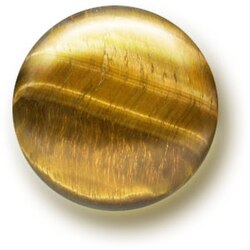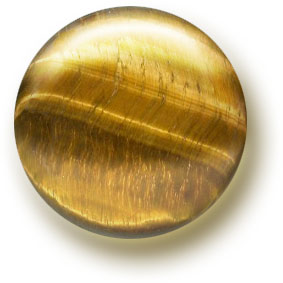Top Qs
Timeline
Chat
Perspective
Chatoyancy
Optical reflectance effect in materials From Wikipedia, the free encyclopedia
Remove ads
In gemology, chatoyancy (/ʃəˈtɔɪ.ənsi/ shə-TOY-ən-see), also called chatoyance or the cat's eye effect,[1] is an optical reflectance effect seen in certain gemstones. (Historically, the term has applied specifically to gems; in woods and other materials the effect is more broadly known as "figure" or iridescence.)
This article's lead section may need to be rewritten. (October 2023) |


Coined from the French œil de chat, meaning cat's eye, the chatoyant effect is typically characterized by one or more well-defined bands of reflected light, reminiscent of a cat's eye, which appear to glide across a gem's surface as the object is moved, or when the observer moves while viewing it.
Chatoyancy is caused by the presence of fibrous structures within the material, such as in tiger's eye quartz, or by fibrous inclusions and cavities, as seen in cat's eye chrysoberyl, in which the effect is caused by the presence of titanium dioxide, which aligns perpendicularly to produce the effect.[2][3]
Remove ads
Description
Summarize
Perspective
Chatoyancy in the gemstone chrysoberyl is induced by the presence of the mineral rutile, a mineral primarily composed of titanium dioxide. These rutile precipitates align perpendicularly, contributing to the cat's eye effect.[4] This alignment is attributed to the rutile's lattice parameter, which matches only one of the three orthorhombic crystal axes of chrysoberyl, leading to its preferred orientation in that direction.
Optimal presentation of effect

To bring out the chatoyancy effect, gemstones are typically fashioned into a cabochon cut, characterized by a rounded, flat base rather than facets, with the fibrous structures aligned parallel to the base. High-quality specimens display a single, sharply defined band of light that moves across the stone when rotated, while lower-quality stones may show a banded effect similar to cat's-eye quartz. Faceted stones do not showcase the effect well.
Varieties of chatoyant materials
Gem species known for this phenomenon include the aforementioned quartz, chrysoberyl, beryl (especially. aquamarine varieties), charoite, tourmaline, labradorite, selenite, feldspar, apatite, moonstone, thomsonite and scapolite amongst others. Chatoyancy is not limited to gemstones but can also be found in various wood species and carbon fiber. Synthetically made gemstones with optical fibers can also have chatoyancy. These gemstones are available in a variety of vibrant colors.[citation needed]
Cat's eye terminology

When the term "cat's eye" is used to describe a gemstone by itself, it typically refers to cat's eye chrysoberyl [5][better source needed]. It can also be used as an adjective to indicate the chatoyance phenomenon in another stone, for example, cat's eye aquamarine.
Remove ads
In woodworking
Summarize
Perspective
Chatoyancy in wood occurs in various species[6] – particularly hardwoods and the various types of Nanmu woods of China and South East Asia, particularly where stresses from the weight of the growing tree result in denser patches, or where stresses cause burl or bird’s eye. This ‘figure’, which has a striking three-dimensional appearance, is highly prized by woodworkers and their clients alike, and is featured regularly in furniture, musical instruments, and other decorative wood products. Figuring takes on a variety of forms and is referred to as flame, ribbon, tiger stripe, quilting, among other names.[7]
This effect is sometimes called wet look, since wetting wood with water often displays the chatoyancy, albeit only until the wood dries. Certain finishes cause the wood grain to become more pronounced. Oil finishes, epoxy, and shellac can strongly bring out the wet look effect. When the refractive index of the finish nearly matches that of the wood, light scattering no longer occurs at the wood surface, adding the appearance of depth to the wood's figure.
Measurement
No method to measure wood chatoyance is unanimously accepted by the scientific community. Some methods have been proposed, such as one named PZC after the names of its inventors, Pisani, Zanetta and Codoro.[8] This measure has been used to measure typical values for a number of wood species; some results are reported below:[9]
Remove ads
See also
- Asterism (gemology) – Star-shaped reflection
- Optical phenomena – Observable events that result from the interaction of light and matter
References
Wikiwand - on
Seamless Wikipedia browsing. On steroids.
Remove ads
